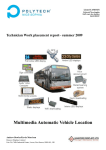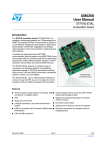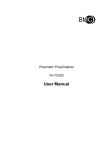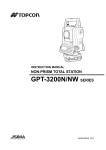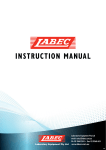Download Air Live DS-100 v2 User`s manual
Transcript
DS-100 v2 Signal bridge between RJ-45 and RS-232 User’s Manual Version 1.0 Copyright and Disclaimer Version 1.0 This guide is written for initial firmware version or later. Copyright & Disclaimer No part of this publication may be reproduced in any form or by any means, whether electronic, mechanical, photocopying, or recording without the written consent of OvisLink Corp. OvisLink Corp. has made the best effort to ensure the accuracy of the information in this user’s guide. However, we are not liable for the inaccuracies or errors in this guide. Please use with caution. All information is subject to change without notice All Trademarks are properties of their respective holders. AirLive DS-100 v2 User’s Manual Table of Contents Table of Contents 1. Introduction.............................................................................................. 1 1.1 Overview............................................................................................ 1 1.2 How to Use This Guide ...................................................................... 3 1.3 Firmware Upgrade and Tech Support ................................................ 4 1.4 Features ............................................................................................ 5 2. Installing the Device Server .................................................................... 6 2.1 Before You Start................................................................................. 6 2.2 Package Content ............................................................................... 6 2.3 Knowing your DS-100 v2 ................................................................... 6 2.3.1 LED Indicator...............................................................................................7 2.3.2 Keypad ........................................................................................................8 2.3.3 Connector Indicator .....................................................................................9 2.4 Hardware Installation ....................................................................... 10 3. Configuring the Device Server.............................................................. 12 3.1 Important Information....................................................................... 12 3.2 Prepare your PC .............................................................................. 12 3.3 Management Interface..................................................................... 13 3.4 Introduction to Web Management .................................................... 13 3.4.1 Welcome Screen and Login.......................................................................13 3.5 Introduction to Web Management .................................................... 14 3.5.1 Getting into Web Management ..................................................................14 4. Web Management in Device Server...................................................... 15 4.1 About the Menu Structure ................................................................ 15 4.2 System Configuration ...................................................................... 16 4.2.1 DS-100 v2 Configuration ...........................................................................16 4.2.2 Gateway/Controller ....................................................................................18 4.2.3 Operation Instructions................................................................................23 5. Troubleshooting .................................................................................... 24 6. Specifications ........................................................................................ 30 7. Network Glossary .................................................................................. 32 1 AirLive DS-100 v2 User’s Manual 1. Introduction 1 1. Introduction 1.1 Overview Whether you are “operating a wireless hotspot service for generating revenue” or “providing free but controlled wireless internet access to guests”, it would be handy to both the operators and the wireless users if the account information (such as username, password, SSID and etc.) can be readily output to POS printers and printed out as account tickets. DS-100 v2 is designed specifically to operate in conjunction with specific Controllers /Gateways. Typical serial POS printers on the market today may or may not be IP network ready, and it is not practical to integrate each brand one-by-one with Controllers /Gateways. Hence, it has specifically designed a smart device server – DS-100 v2, for two purposes: 1. Attaching before a serial POS printer so that one or more POS printers can be connected to a Controller/Gateway via IP networks. 1 AirLive DS-100 v2 User’s Manual 1. Introduction 2. Pre-integrated with the Controller/Gateway so that account generation becomes quick and easy to the operator, simply by a push of buttons on the device. It provides DS-100 v2 and a POS printer as a combo set called Network Ticket Generator. The followings are typical application scenarios: A small business who wishes to quickly set up a wireless service hotspot for charged Internet service may purchase a Gateway, and a Network Ticket Generators set. The Gateway alone serves as an AP and a gateway, Network Ticket Generator enables the registration operator to generate and issue accounts via push buttons on the DS-100 v2 and hand out the account ticket printed out by POS printer. A corporate has several sites. Deployed at the reception area of each site are with a DS-100 v2 and a POS printer. Guests who need wireless connection to the internet simply need to request the receptionist and obtain a slip with account information. The guest account will automatically expire after the pre-configured time. A hotel has a Controller/Gateway and multiple APs within its hospitality areas. Multiple sets of Network Ticket Generator are distributed at the service desks and lounge counters. The service clerks are able to create accounts for their guests with charged or free internet service depending on the hotel’s service model. Below are two network diagrams examples using Network Ticket Generator combo set. (1) One Gateway with one Network Ticket Generator set. (2) One Gateway with multiple Network Ticket-Generator sets. 2 AirLive DS-100 v2 User’s Manual 1. Introduction *Note: The POS printer has an individual manual, therefore, its configuration details is not covered in this guide. Though DS-100 v2 is specifically designed to for on-demand account generation and operate POS printers, it can also be deployed independently to connect other RS232 devices to an Ethernet network for remote operation. If you will be deploying DS-100 v2 independently to manage other serial devices, please carefully set the Serial Settings in DS-100 v2 to match the operating needs of your serial device. *Note: If you connect other serial device to DS-100 v2 and are unable to remotely operate your connected serial device, please check that: The settings under Serial Settings of DS-100 v2 are configured to match your serial device operating requirements. If your serial device application operates on pure serial communication then you need to setup a COM port redirector. 1.2 How to Use This Guide Recommended Reading Chapter 1: This chapter explains the basic information for DS-100 v2. It is a must read. Chapter 2: This chapter is about hardware installation. You should read through the entire chapter. 3 AirLive DS-100 v2 User’s Manual 1. Introduction Chapter 3: 3.1 Important Information: This section has information of default setting such as IP, Username, and Password. 3.2 Management Interface: This section introduces Web management. 3.3 Introduction to Web Management: This section tells you how to get into the Web UI using HTTP. Chapter 4: This chapter explains all of the management functions via Web management. Chapter5: This chapter shows technical specification of DS-100 v2. Chapter 6: Explanation on network technical terms from A to Z. Highly recommended for reference when you encounter an unfamiliar term. 1.3 Firmware Upgrade and Tech Support If you encounter a technical issue that cannot be resolved by information on this guide, we recommend that you visit our comprehensive website support at www.airlive.com. The tech support FAQ are frequently updated with latest information. In addition, you might find new firmwares that either increase software functions or provide bug fixes for DS-100 v2. You can reach our on-line support center at the following link: http://www.airlive.com/support/support_2.jsp Since 2009, AirLive has added the “Newsletter Instant Support System” on our website. AirLive Newsletter subscribers receives instant email notifications when there are new download or tech support FAQ updates for their subscribed airlive models. To become an AirLive newsletter member, please visit: http://www.airlive.com/member/member_3.jsp 4 AirLive DS-100 v2 User’s Manual 1. Introduction 1.4 Features 1 x 10/100Mbps RJ-45 port + 2 x RS-232 DB9 Serial port Trigger the Built-in On-Demand Billing Plan inside the M-series Controller Web Management via web browser 7 Segment LED display 6 Matrix function keys Up to 921.6 Kbps baud rate supported Ethernet activity, Power LED's Monitor, manage and control industrial field devices remotely Support TCP Server/ Client link mode DHCP, BOOTP, Static IP, and ARP supported Over Voltage Protection Wide Voltage Support Wall-mount Rugged metal case with IP50 compliance for industrial usage Provide Screw Terminal Block 5 AirLive DS-100 User’s Manual 2. Installing the Device Server 2 2. Installing the Device Server This chapter describes the hardware features and the hardware installation procedure for the DS-100 v2. For software configuration, please go to chapter 3 for more details. 2.1 Before You Start It is important to read through this section before you install the DS-100 v2. The maximum cabling distance is 100 meters. Make sure that the connection between DS-100 v2 and PC/NB is well established Always check the LED lights for troubleshooting 2.2 Package Content Unpack the contents of the DS-100 v2 and verify them against the checklist below. One unit of DS-100 v2 12V/1A Power Adapter Quick Installation Guide Compare the contents of your DS-100 v2 package with the standard checklist above. If any item is missing or damaged, please contact your local dealer for service. 2.3 Knowing your DS-100 v2 Below are descriptions and diagrams of the product: AirLive DS-100 v2 User’s Manual 6 2. Installing the Device Server 2.3.1 LED Indicator The LED Indicators gives real-time information of systematic operation status. The following table provides descriptions of LED status and their meaning. LED Description Power On: Power on. Off: Power off. Status On: The device associated with Hotspot. Off: The device unassociated with Hotspot. Flash: The FUNCTION key activated. Lock On: The Keypad locked; Off: The Keypad unlocked; Flash: Input digit number key for unlocking. Link/Act 100M : Link and activity of Ethernet port Link speed of Ethernet port. 7 AirLive DS-100 v2 User’s Manual 2. Installing the Device Server 2.3.2 Keypad Keypad Keypad Description PRE (-) /POS (+) Enter (►) Function ( ) CANCEL (X) REPEAT (R) There are two functions: Increase (POS) and Decrease (PRE) number for selecting Plan or Function option. Reset to factory default: Press and Hold two button for more than 5 seconds (until Status LED FLASH) to reset the device to default configurations. Click to print On-Demand Account Tickets or Function selected. Lock Keypad: Press and Hold button until Lock LED ON. Unlock Keypad: Press button until Lock LED FLASH, then input key for unlocking. Lock Keypad: Press and Hold button until Lock LED ON. Link Test: Click button and then select number 1 then click Enter. Statement Printing: Click on this button, it will print out account balance according press the numbers. I. Current Balance: Select Number 9 and clicks Enter, it will print out current balance. II. Early Balance: Select Number 8 and clicks Enter, it will print out early balance. Stop to print Statement. Clear input key for unlocking. Cancel other event Repeat to print previous Tickets. AirLive DS-100 v2 User’s Manual 8 2. Installing the Device Server *Note: The Lock/Unlock function, please refer to Chapter 5 for more detail installation. 2.3.3 Connector Indicator Top Panel Connector Description Reset Button The power socket for connecting to an external power source through the power adapter provided in the package. For DC Power input, please refer to Chapter 5 for more detail information. For reboot only. Ethernet Port Ethernet port for connecting to a hotspot gateway. DC Power Jack (12V/1A) Screw Terminal Block Bottom Panel 9 AirLive DS-100 v2 User’s Manual 2. Installing the Device Server Connector COM 1 COM2 Description Serial Port for connection with a POS printer. Serial Port for connection with a POS printer. Used for back up when COM 1 malfunctions. 2.4 Hardware Installation The following diagram illustrates how to connect DS-100 v2 to the POS printer and Gateways/Controllers. Please follow the steps described below to install hardware: (1) Attach DS-100 v2 to a power source, either through adaptors provided in the package or through DC socket with a DC power supply. (1) Attach POS printer to a power source, through adaptors provided in the package and turn on the power switch situated on the left side of the device. (2) Connect POS printer to the COM1 port of DS-100 v2 by a RS-232 cable provided within POS printer package. (3) Connect DS-100 v2 to the LAN port of your Gateway/Controller by an Ethernet cable. AirLive DS-100 v2 User’s Manual 10 2. Installing the Device Server *Note: You need to connect to the correct LAN port if your Gateway/Controller is operating in Port-based mode. A. B. C. Make sure mounting surface on the bottom of the DS-100 v2 is grease and dust free. Remove adhesive backing from your Rubber Feet. Apply the Rubber Feet to each corner on the bottom of the DS-100 v2. These footpads can prevent the Switch from shock/vibration. 11 AirLive DS-100 v2 User’s Manual 3. Configuring the Device Server 3 3. Configuring the Device Server DS-100 v2 is designed specifically to operate in conjunction with all Gateways/Controllers. If you are not using default settings, before connecting DS-100 v2 to your Gateway/Controller, some configurations steps are required. The configuration instructions for Gateways/Controllers and DS-100 v2 are covered in the following sections. 3.1 Important Information The following information will help you to get start quickly. However, we recommend you to read through the entire manual before you start. Please note the username and password are case sensitive. The default IP address is: 192.168.1.10 Subnet Mask: 255.255.255.0 The default Gateway is: 192.168.1.254 3.2 Prepare your PC The DS-100 v2 can be managed remotely by a PC through RJ-45 cable. The default IP Address of the DS-100 v2 is 192.168.1.10 with a subnet mask of 255.255.255.0. This means the IP address of the PC should be in the range of 192.168.1.2 to 192.168.1.253 (do not include 192.168.1.10). To prepare your PC for management with the DS-100 v2, please do the following: 1. 2. Connect your PC directly to the copper port of DS-100 v2 Set your PC’s IP address manually to 192.168.1.100 (or other address in the same Subnet) AirLive DS-100 v2 User’s Manual 12 3. Configuring the Device Server You are ready now to configure the DS-100 v2 by using your PC. 3.3 Management Interface The DS-100 v2 can be configured using on the Web management interfaces. Web Management (HTTP): You can manage your DS-100 v2 by simply typing its IP address in the web browser. Most functions of DS-100 v2 can be accessed by web management inter face. We recommend using this interface for initial configurations. To begin, simply enter DS-100 v2’s IP address (default is 192.168.1.10) on the web browser. 3.4 Introduction to Web Management 3.4.1 Welcome Screen and Login The DS-100 v2 offers Web Management interfaces for users. Users can easily access and control DS-100 v2 via web browsers. The Web-Based Management supports Internet Explorer 5.0. It is based on Java Applets with an aim to reduce network bandwidth consumption, enhance access speed and present an easy viewing screen. 13 AirLive DS-100 v2 User’s Manual 3. Configuring the Device Server 3.5 Introduction to Web Management We recommend users to browse through DS-100 v2’s web management interface to get an overall picture of the functions and interface. Below are the recommended initial configurations for first time login: *Note: By default, IE5.0 or later version does not allow Java Applets to open sockets. The user has to explicitly modify the browser setting to enable Java Applets to use network ports. 3.5.1 Getting into Web Management Web Management (HTTP) 1. Launch the Internet Explorer. 2. Type http://192.168.1.10/setting.htm , and then press “Enter”. 3. The home screen of the Web-based management appears. AirLive DS-100 v2 User’s Manual 14 4. Web Management in Device Server 4 4. Web Management in Device Server In this chapter, we will explain all settings in web management interface. Please be sure to read through Chapter 3.4’s “Introduction to Web Management” first. 4.1About the Menu Structure The web management menu of DS-100 v2 is divided into 4 parts: Serial Settings, Network Settings and Firmware Upgrade. COM1 Setting(Serial Settings corresponding to POS printer) Data Baud Rate Select the desired baud rate. (The number of characters per second transferred) Select the number of bits in each character. Data Bits 15 AirLive DS-100 v2 User’s Manual 4. Web Management in Device Server Data Parity Stop Bits Flow Control Network Settings Static IP Address Static Subnet Mask Static Default Gateway Static DNS Server Transmit Timer Server Listening Port Firmware Upgrade Choose between Even or Odd for error detection, or select None for no error detection. Choose the number of stop bits to be sent at the end of every character. Electronic devices usually use 1 bit, slower electromechanical devices use 1.5 bit. Choose the method of flow control to pause and resume the transmission of data to coordinate with printer speed. Select None if flow control is not required. The static IP address assigned to DS-100 v2. The subnet mask of DS-100 v2. The default gateway of DS-100 v2. Set the DNS server used by DS-100 v2. TCP transmit timer, set the desired value or use default value. When the timer expires for a sent packet, sender will retransmit the packet. Set the port number for communication with the Gateway/Controller. Upgrade firmware from remote-PC via Ethernet. 4.2System Configuration DS-100 v2 is designed specifically to operate in conjunction with all Gateways/Controllers. If you are not using default settings, before connecting DS-100 v2 to your Gateway/Controller, some configurations steps are required. The configuration instructions for Gateways/Controllers and DS-100 v2 are covered in the following sections. 4.2.1DS-100 v2 Configuration DS-100 v2 supports web based configuration. By factory default, DS-100 v2 web interface can be accessed with IP address: 192.168.1.10 Subnet Mask: 255.255.255.0 Default Gateway: 192.168.1.254 Step1: Configure administrator PC’s TCP/IP settings with a static IP address that is under the same subnet mask as DS-100 v2. For example: 192.168.1.100 AirLive DS-100 v2 User’s Manual 16 4. Web Management in Device Server Step2: Attach DS-100 v2 to a power supply using the adapter provided in the package. Connect the administrator PC to the Ethernet Port of DS-100 v2 via an Ethernet cable. Launch a web browser and type in the default IP address of DS-100 v2 in the address field (http://192.168.1.10/setting.htm ), the web interface of DS-100 v2 should appear. 17 AirLive DS-100 v2 User’s Manual 4. Web Management in Device Server Step3: Change DS-100 v2 Network Settings if necessary so that the IP address of DS-100 v2 is under the same subnet as the Gateway/Controller’s interface, which DS-100 v2 will be connected to. Click Apply to save the settings. 4.2.2 Gateway/Controller WIAS-3200N v2 provides wireless and wired network service with On-Demand authentication for clients in Service Domain. Administrator can select Billing Plan on each WP-610T/WP-620T Thermal Printer. If Billing Plan is enabled, the Thermal Printer can generate On-Demand's tickets. The clients are required to get authenticated successfully before access the Internet. Configuration Steps: Step 1. Create Billing Plans. Click Service Domain > Authentication > On-Demand > Billing Plans Setup, the Billing AirLive DS-100 v2 User’s Manual 18 4. Web Management in Device Server Plans List page will appear. Here provides 10 sets of independent billing plans. Select desired Billing Plan and click Edit, and then setup page will appear. Enable Billing and set desired billing plan for uses used. Below depicts an example for Billing Plan 0 (ondemand0). Step 2. Set Virtual AP and Select On-Demand's Authentication for Service Domain Click Service Domain, the Service Domain Setup page will appear. Set VAP0 in Domain1 and select On-Demand in Authentication Type. Below depicts an example for Domain1 with AP0 and On-Demand's authentication. 19 AirLive DS-100 v2 User’s Manual 4. Web Management in Device Server Step 3. Select Billing Plans for Thermal Printer. Click Service Domain > Authentication > On-Demand > Thermal Printer Setup, the Thermal Printer List page will appear. Select desired Thermal Printer and click Edit, and then setup page will appear. Enable Thermal Printer and set related setting with DS-100 v2. Then select desired Billing Plan for Thermal Printer. Below depicts an example. Step 4. Reboot WIAS-3200N v2 Click Reboot button to enable new setting. AirLive DS-100 v2 User’s Manual 20 4. Web Management in Device Server Step 5. DS-100 v2 Link Test. After reboot, the DS-100 v2’s Status LED should be ON. Press FUNCTION button, the Status LED should be FLASH. Select in number 1 and press Enter button, the Thermal Printer should be print “Thermal Printer Link Test!” message. Press CANCEL button to stop function event, the Status LED should be ON. Step 6. Generate On-Demand's Ticket from Thermal Printer. Press POS or PRE button, select desired Billing Plan (e.g Plan 0~2 for this example) and click Enter button to print ticket for your visitor. This ticket contains a unique login Passcode. (1) Plan 0: (2) Plan 1: 21 AirLive DS-100 v2 User’s Manual 4. Web Management in Device Server (3) Plan 2: Step 7. User your Ticket to Access Internet. Connect a client device (e.g. Notebook) with wireless interface to scan the configured ESSID of WIAS-3200N v2 (e.g. Air@Live0) and get associated with this ESSID. The client device will obtain an IP address automatically via DHCP from WIAS-3200N v2. Open a web browser on a client device, access any URL, and then the Domain1 User Login Page will appear. Enter the Passcode of a printer ticket previously generated via DS-100 v2 Thermal Printer. Then, click Login button. Below depicts an example for login with Passcode. *Congratulation! The success page as below will appear after a client has successfully logged into AC920X and has been authenticated by the system. Now, you are connected the network and Internet! AirLive DS-100 v2 User’s Manual 22 4. Web Management in Device Server 4.2.3Operation Instructions After completing the Hardware Setup and the devices are physically connected, the system is ready for operation. This section will describe how to operate DS-100 v2 to print out tickets for enabled billing plans. 1. Select an enabled billing plan number on DS-100 v2 by PRE (-) button. The numeric LED display on the center of the device represents the billing plan number currently selected. 2. Press ENTER button on DS-100 v2 to create and print out an on-demand account of the selected billing plan. POS PRINTER will print out the ticket with the text format (Without background image) configured on your Gateway/Controller in Ticket Customization. *Note: If you are unable to get a ticket printout after pressing ENTER button, please check if the selected plan is enabled. 23 AirLive DS-100 v2 User’s Manual 5. Troubleshooting 5 5. Troubleshooting This section is intended to help you solve the most common problems on the DS-100 v2. Q1: How to upgrade firmware? A1: To upgrade the firmware, the Software tools tftpd32 is required, please download and install Tftpd32 from the link: http://tftpd32.jounin.net/tftpd32.html, and then please check the following steps. Step1: Place the new firmware of DS-100 v2 on a local location (for example D:\Shared) in the PC that is accessing DS-100 v2’s web interface and performing the upgrade. Step2: Configure the TCP/IP settings of your PC with an IP address under the same subnet mask as DS-100 v2. For example 192.168.1.155 Step3: Configure the tftpd32. 1. In “Current Directory” field, browse for the location path where the firmware is stored. 2. Enter the IP address of your PC in “Server interfaces” field. 3. In “IP pool starting address” field, enter the start IP address of an IP segment that is available for allocation. 4. Set the size of the IP pool. 5. Enter the firmware filename in “Boot file field”. 6. Enter 255.255.0.0 in the “Mask” field. 7. Click Save button. AirLive DS-100 v2 User’s Manual 24 5. Troubleshooting *Note: Please make sure that the location path and the firmware for upgrade is correct. Step4: Click “Firmware Upgrade” button on DS-100 v2’s web interface. DS-100 v2 will automatically restart and connect to tftpd32 server to perform the firmware upgrade. Step5: When completed, check the information displayed at Software Version, DS-100 v2 has successfully upgraded to the new firmware. 25 AirLive DS-100 v2 User’s Manual 5. Troubleshooting Q2: How to Lock and Unlock Keypad for On-Demand Authentication? A2: This function is for protect other people to press DS-100 v2 and print out the tickets, you can follow the below installation steps to configure your hotspot gateway and device server. On WIAS-3200N v2 Web UI. (1) Select a Service Domain’s Authentication Type as On-Demand. (2) Under Service Domain > Authentication > On-Demand > Billing Plan Setup: Enable and save a billing plan. (3) Under Service Domain > Authentication > On-Demand > Thermal Printer Setup: Edit a thermal printer. After enabling it, provide a 4 to 8 –digit Lock Password. Save everything and reboot the WIAS-3200N v2. AirLive DS-100 v2 User’s Manual 26 5. Troubleshooting On the DS-100 v2 keypad: (1) After WIAS-3200N v2 reboots, press the Function button (left-down) for a while until the Lock LED turns solid on. Now the keypad is locked. (2) To unlock the keypad, press the Function button (left-down) for a while until the Lock LED starts to blink. (3) Select the Lock password digits one by one by pressing the PRE (-) or POS (+) buttons and then pressing Enter button after each digit. After all the keys are input, the Lock LED will turns off, which denotes the keypad is unlocked. *Note: The default password for DS-100 v2 is “1111”. 27 AirLive DS-100 v2 User’s Manual 5. Troubleshooting Q3: Diagnosing LED Indicators A3: The DS-100 v2 can be easily monitored through panel indicators to assist in identifying problems, which describes common problems you may encounter and where you can find possible solutions. Please refer to Chapter 2.3.1 for detailed information. If the power indicator does turn on when the power cord is plugged in, you may have a problem with power outlet, or power cord. However, if the Switch powers off after running for a while check for loose power connections, power losses or surges at power outlet. If you still cannot resolve the problem, contact your local dealer for assistance. Q4: Troubleshoot of cabling A4: RJ-45 ports: It uses unshielded twisted-pair (UTP) or shield twisted-pair (STP) cable for RJ-45. Connections: 100Ω Category 3, 4 or 5 cable for 10Mbps connections or 100Ω Category 5 cable for 100Mbps connections. Also be sure that the length of any twisted-pair connection does not exceed 100 meters (328 feet). Gigabit port should use Cat-5 or cat-5e cable for 1000Mbps connections. The length does not exceed 100 meters. RS-232 Serial port: a common type of electrical connector used particularly in computers. They are among the largest common connectors used with computers. The one side of cable connecting to DS-100 v2 should be DB-9 Female plug, the other side depends on POS printer’s specification. Q5: How to use STB power convertor? A5: Fig. 1 AirLive DS-100 v2 User’s Manual Step 1. For any DC power input, you may use STB as power convertor. Two type of STB connectors were used, 2-pole and 3-pole. Loosen the screw on top of the STB-male connector (Fig.1) Plug in the ground pin of your DC power into the right position hole 28 5. Troubleshooting Step 2. Plug in the DC power into the left position hole of STB-male connector, as shown in Fig 2-1 & Fig.2-2 Fig. 2-1 (for 3-pole) Fig. 2-2 (for 2-pole) Step 3. Tighten up the screw on top of the STB-male connector, makes sure the DC Step 4. Insert the STB-female connector to the rear side of device, as shown in Fig. 3-1 and Fig. 3-2. Fig.3-1 Fig. 3-2 *Note: * Check the DC power apply to DTB connector fist, makes sure the DC power is 29 AirLive DS-100 v2 User’s Manual 6. Specifications 6. Specifications 6 This section provides the specifications of DS-100 v2, and the following table lists these specifications. Hardware Specification RISC CPU CPU Indicators (LED) Power 10Base-T connection 100Base-TX connection Link Status Keypad Status Display One 7 segment LED display Keypad 6 matrix function keys Firmware Upgradeable via TFTP and serially Serial Interface Serial Port DB-9-DTE(male) * 2 Data Rates COM1 : 1200 to 921600 bps COM2 : 9600 bps Characters 5, 6, 7, 8 Parity Odd , Even, None Stop Bits 1 or 1.5 Flow Control XON/ XOFF (Software), RTS/ CTS (Hardware), None Network data bits Interface Interface Ethernet 10Base-T or 100Base-Tx (Auto-Sensing) Connector RJ45 * 1 Setup HTTP Browser Setup Link Mode TCP Server/Client Protocols TCP, UDP, ICMP, IPv4, DHCP, BOOTP, ARP, DNS, ICMP, Telnet, DHCP, HTTP AirLive DS-100 v2 User’s Manual 30 6. Specifications Environmental & Mechanical Characteristics Temperature Operating :0 °C ~ 60 °C Storage : 0 °C ~ 70 °C Humidity Operating : 10% to 80% Non-Condensing Storage :5% to 90% Non-Condensing Power Consumption 1.68W Power 12-60 VDC Isolation Power Supply Serial: Transient protection for data lines (TX and RX) to ±15KV(air),±8KV(contact) RJ45: Transient protection for data lines (TX and RX) to ±15KV(air),±8KV(contact) Power Input: 1500W peak pulse power capability with 10/1000 us waveform repetitive rate (duty cycle) : 0.01% ; Uni and Bidirectional DC Jack: 110 – 220V AC Power; 12 VDC, 1.A input. Screw Terminal Block : 12-60 VDC Unit Weight 280g Unit Dimensions 11* 9* 2.5 cm (L x W x H) Material Metal enclosure Form Factor Wall Mount 31 AirLive DS-100 v2 User’s Manual 7. Network Glossary 7 7. Network Glossary The network glossary contains explanation or information about common terms used in wireless networking products. Some of information in this glossary might be outdated, please use with caution. 100Base-TX Also known as 802.3u. The IEEE standard defines how to transmit Fast Ethernet 100Mbps using Cat.5 UTP/STP cable. The 100Base-TX standard is backward compatible with the 10Mbps 10-BaseT standard. DHCP Dynamic Hosting Configuration Protocol. A protocol that enables a server to dynamically assign IP addresses. When DHCP is used, whenever a computer logs onto the network, it automatically gets an IP address assigned by DHCP server. A DHCP server can either be a designed PC on the network or another network device, such as a router. Firmware The program that runs inside embedded device such as AP or Switch. Many network devices are firmware upgradeable through web interface or utility program. FTP File Transfer Protocol. A standard protocol for sending files between computer over a TCP/IP network and the internet. IP Address IP (Internet Protocol) is a Layer 3 network protocol that is the basis of all Internet communication. An IP address is 32-bit number that identifies each sender or receiver of information that is sent across the Internet. An IP address has two parts: an identifier of a particular network on the Internet and an identifier of the particular device (which can be a server or a workstation) within that network. The new IPv6 specification supports 128-bit IP address format. Packet A unit of data sent over a network. Subnet Mask An address code mask that determines the size of the network. An IP subnet are determined by performing a BIT-wise AND operation between the IP address and the subnet mask. By changing the subnet mask, you can change the scope and size of a network. AirLive DS-100 v2 User’s Manual 32 7. Network Glossary TFTP Trivial File transfer Protocol. A file transfer protocol, with the functionality of a very basic form of FTP. It is used to transfer small amounts of data between hosts on a network, such as Switch firmware. 33 AirLive DS-100 v2 User’s Manual








































